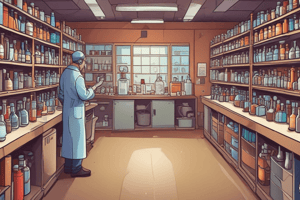Podcast
Questions and Answers
What is an ideal solution?
What is an ideal solution?
- A solution that evolves or absorbs heat during the mixing process
- A solution where there is no change in the properties of the components, other than dilution, when they are mixed (correct)
- A solution where the escaping tendency of the components is not quantitatively measurable
- A solution that experiences shrinkage or expansion when the substances are mixed
What does free energy quantitatively measure?
What does free energy quantitatively measure?
- The ability of water molecules to escape the surface into vapor
- The heat flow between two bodies in thermal equilibrium
- The vapor pressure of a solution
- The escaping tendencies of material substances undergoing transformations (correct)
Which property serves as a quantitative expression of escaping tendency?
Which property serves as a quantitative expression of escaping tendency?
- Heat flow between two bodies in thermal equilibrium
- Vapour pressure of a solution (correct)
- Ability of water molecules to escape the surface into vapor
- Heat evolved or absorbed during the mixing process
What does Raoult's law describe in relation to solutions?
What does Raoult's law describe in relation to solutions?
What is the phenomenon described by Henry's law?
What is the phenomenon described by Henry's law?
What is the formula for calculating the partial vapor pressure of a component in a solution according to Raoult's Law?
What is the formula for calculating the partial vapor pressure of a component in a solution according to Raoult's Law?
In which type of deviation from Raoult's law does the boiling point of a solution increase?
In which type of deviation from Raoult's law does the boiling point of a solution increase?
What happens to the vapor pressure of a solvent when solute molecules are added to a solution?
What happens to the vapor pressure of a solvent when solute molecules are added to a solution?
What formula can be used to calculate osmotic pressure for non-electrolyte solutions?
What formula can be used to calculate osmotic pressure for non-electrolyte solutions?
What is the practical osmotic coefficient (Φ) in the context of electrolytes?
What is the practical osmotic coefficient (Φ) in the context of electrolytes?
How is the amount in moles of osmotically active species in solution expressed?
How is the amount in moles of osmotically active species in solution expressed?
What happens to bacteria when exposed to strongly hypertonic solutions?
What happens to bacteria when exposed to strongly hypertonic solutions?
Why is it important for eye medication to be isotonic?
Why is it important for eye medication to be isotonic?
What is the relationship between two solutions that have the same osmotic pressure?
What is the relationship between two solutions that have the same osmotic pressure?
Flashcards are hidden until you start studying
Study Notes
- Water molecules turn into vapor when the pressure applied on its surface is low. The opposite is also true: the higher the pressure, the harder it is for molecules to become vapor.
- Raoult's Law: The vapor pressure of a solution is an expression of the escaping tendency of its volatile constituents. The partial vapor pressure of each component is equal to the vapor pressure of the pure constituent multiplied by its mole fraction in the solution. (PA = XAP₀A, PB = XBP₀B)
- In an ideal solution, the vapor pressure of a constituent is reduced by dilution with another constituent in a manner that depends on their mole fractions.
- CFCs (Chlorofluorocarbons) are used as propellants in MDIs (Metered Dose Inhalers) due to their suitable blends and intermediate vapor pressure.
- Real solutions, also known as non-ideal solutions, exhibit adhesion forces between constituents that are stronger than the cohesion forces within the pure constituents. Such solutions do not follow Raoult's law.
- Two types of deviation from Raoult's law: positive and negative. In positive deviation, the adhesion forces between the constituents are weaker than the cohesion forces, which results in a boiling point lower than expected. In negative deviation, the adhesion forces are stronger than the cohesion forces, causing a boiling point higher than expected.
- Colligative properties: depend on the number of solute particles present in a solution and not on the nature of the constituents. Among these properties are the vapor pressure lowering, boiling point elevation, freezing point depression, and osmotic pressure.
- Vapor pressure lowering: As solute molecules are added to a solution, the vapor pressure of the solvent decreases, which results in a lowering of the vapor pressure of the solution.
- Boiling point elevation: When a solute is added to a solvent, the boiling point of the solution increases.
- Osmosis: A semi-permeable membrane separates a solution from a solvent. The solvent passes through the membrane into the solution, diluting it. The osmotic pressure is the pressure required to stop this process. For non-electrolytes, the osmotic pressure can be calculated using the formula pV = nRT, where n is the number of moles of solute, V the volume of the solution, and R the gas constant. For real solutions, the activity rather than the concentration should be used. Real solutions have a lower osmotic pressure than their concentration would lead us to expect.
Studying That Suits You
Use AI to generate personalized quizzes and flashcards to suit your learning preferences.




